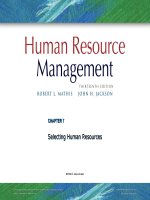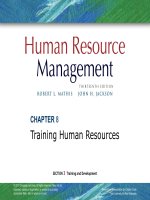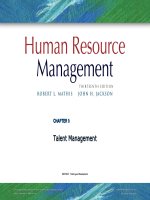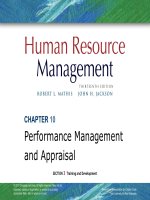Human resrouce management 13th mathis jacson chapter 06
Bạn đang xem bản rút gọn của tài liệu. Xem và tải ngay bản đầy đủ của tài liệu tại đây (1.24 MB, 29 trang )
CHAPTER 6
Recruiting and Labor Markets
SECTION 2 Jobs and Labor
© 2011 Cengage Learning. All rights reserved. May not be
scanned, copied or duplicated, or posted to a publicly
accessible Web site, in whole or in part.
PowerPoint Presentation by Charlie Cook
The University of West Alabama
Chapter Objectives
After you have read this chapter, you should be able to:
• List different ways that labor markets can be identified and
approached.
• Discuss strategic recruiting decisions on recruiting images,
outsourcing, and other related areas.
• Explain why Internet recruiting has grown and how it affects
recruiting efforts done by employers.
• List and briefly discuss five external recruiting sources.
• Identify three internal sources for recruiting and issues associated
with their use.
• Describe three factors to consider when doing recruiting
measurement and metrics.
The Importance of Recruiting
• Recruiting
Is the process of generating a pool of qualified
applicants for organizational jobs
Seeks to improve workforce quality for competitive
advantage:
Cost of
recruiting
Quality of
recruited
candidates
Cost of
unfilled jobs
FIGURE 6–1
Integrating Recruiting Components
Strategic Recruiting and HR Planning
• Effective Recruiting Requires:
Knowing the business and industry
Identifying keys to success in the labor market
Cultivating networks and relationships
Promoting the “company brand”
Using metrics to measure recruiting effectiveness
Identifying talent before it is needed
• Training Recruiters and Managers
Recruiting-related job skills
Diversity and sensitivity skills
Ethical recruiting behaviors
Labor Markets
• Labor Markets
The external supply pool from which organizations
attract their employees
• Unemployment Rates and Applicant Population
Low unemployment creates competition for
employees, raising labor costs.
High unemployment results the availability of more
applicants and more qualified applicants.
FIGURE 6–2
Labor Market Components
FIGURE 6–3
Considerations for Determining Applicant Populations
Reaching the Applicant Population
Recruiting
Decisions
Recruiting
Method
Recruiting
Message
Applicant
Qualifications
Administrative
Procedures
Different Labor Markets and Recruiting
Geographic Labor
Markets
Global Labor
Markets
Labor
Markets
Industry and
Occupational Labor
Markets
Educational and
Technical Labor
Markets
Strategic Recruiting Decisions
Organization-Based
vs.
Sample
Outsourced Recruiting
Recruiting Source
Choices:
Internal vs. External
Recruiting
Nontraditional
Sample
Workers
Recruiting Presence
Sample
and Image
Strategic
Sample
Recruiting
Decisions
Recruiting and EEO:
Diversity
Sample
Considerations
Training of
Sample
Recruiters
Regular vs.
Sample
Flexible
Staffing
Realistic Job
Sample
Previews
FIGURE 6–4
Recruiting and Diversity Considerations
Internet Recruiting
Effects of Internet Recruiting
Adjusting to
new recruiting
approaches
Identifying new
types of recruiting
for specific jobs
Training for
managers and
HR recruiters
Internet Recruiting (cont’d)
E-Recruiting Places
Internet Job
Boards
Professional/
Career Websites
Employer
Websites
Recruiting and Internet Social Networking
Social Networking Recruiting Advantages:
• Allows job seekers to connect with employees of potential
employers
• Allows employers to engage in social collaboration by joining
and accessing social technology networks to help applicants
post resumes and complete applications online
Recruiting Using Special Technology Means
Internet Recruiting Tools
Blogs
E-Video
Legal Issues in Internet Recruiting
The use (or misuse) of
screening software
Collection of federally required
applicant information
Exclusion of protected classes
from the process
Proper identification of
“real” applicants
Maintaining confidentiality
and privacy
Legal Issues in
Internet
Recruiting
Internet Recruiting
Advantages
Disadvantages
• Recruiting cost savings
• Recruiting time savings
• Expanded (global) pool of
applicants
• Better targeting of specific
audiences
• More unqualified applicants
• Additional work for HR staff
• Many applicants are not
seriously seeking employment
• Access limited or unavailable to
some applicants
• Privacy of information and
discrimination issues
External Recruiting
Media Sources
Competitive
Recruiting Sources
Employment
Agencies
External
Recruiting
Sources
Labor Unions
Job Fairs
Educational
Institutions
FIGURE 6–5
Advantages and Disadvantages of External Recruiting
FIGURE 6–6
What to Include in an Effective Recruiting Ad
FIGURE 6–7
College Recruiting: Considerations for Employers
Internal Recruiting
Employee
Databases
Job
Postings
Internal
Recruiting
Sources
Former
Employees
and Applicants
Promotions
and Transfers
CurrentEmployee
Referrals
FIGURE 6–8
Advantages and
Disadvantages of
Internal Recruiting
Recruiting Evaluation and Metrics
Evaluating Recruiting
Quality and Quantity
Evaluating Recruiting
Satisfaction
Evaluating
Recruiting
Efforts
Evaluating the Time
Required to Fill
Openings
Evaluating the Cost
of Recruiting









